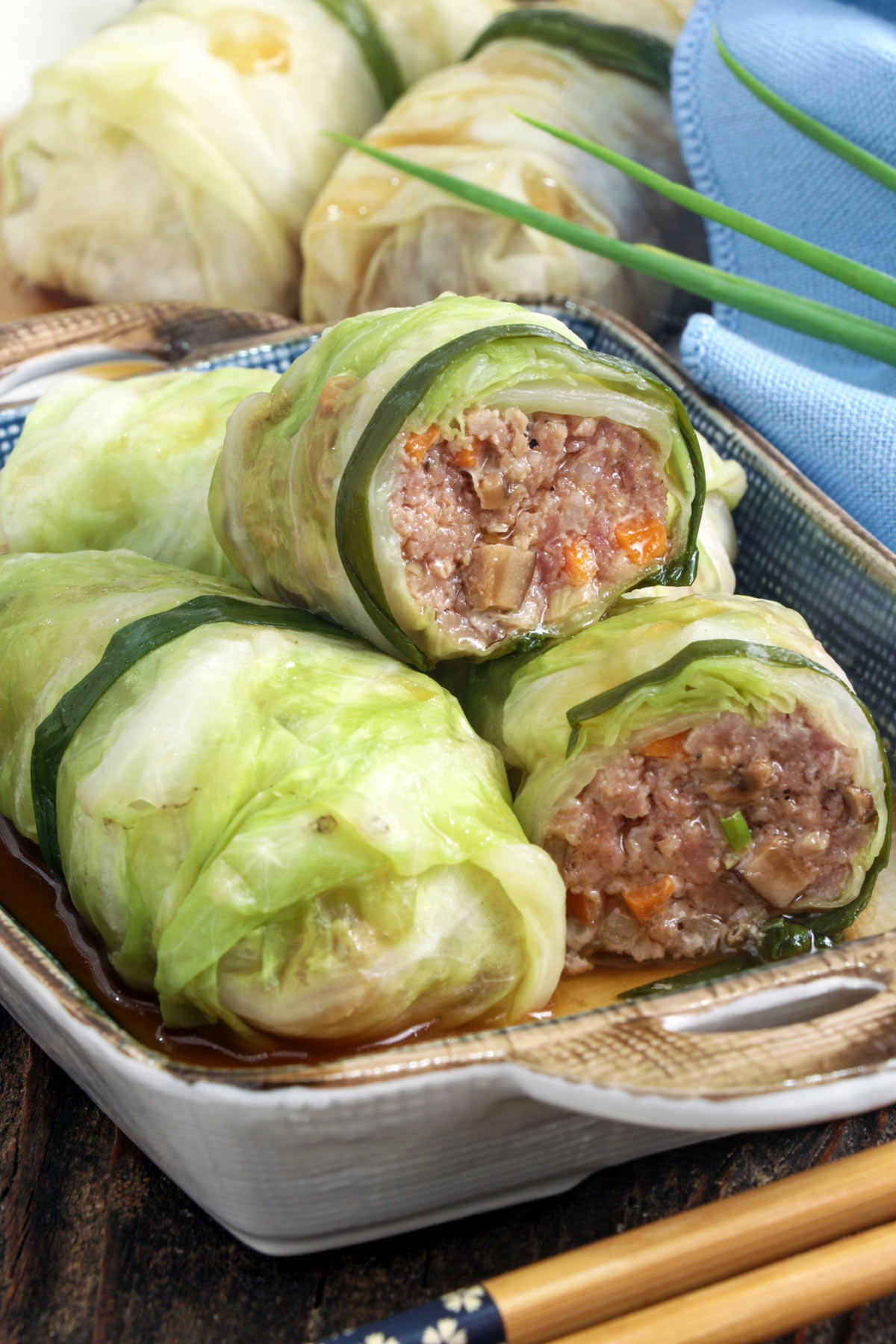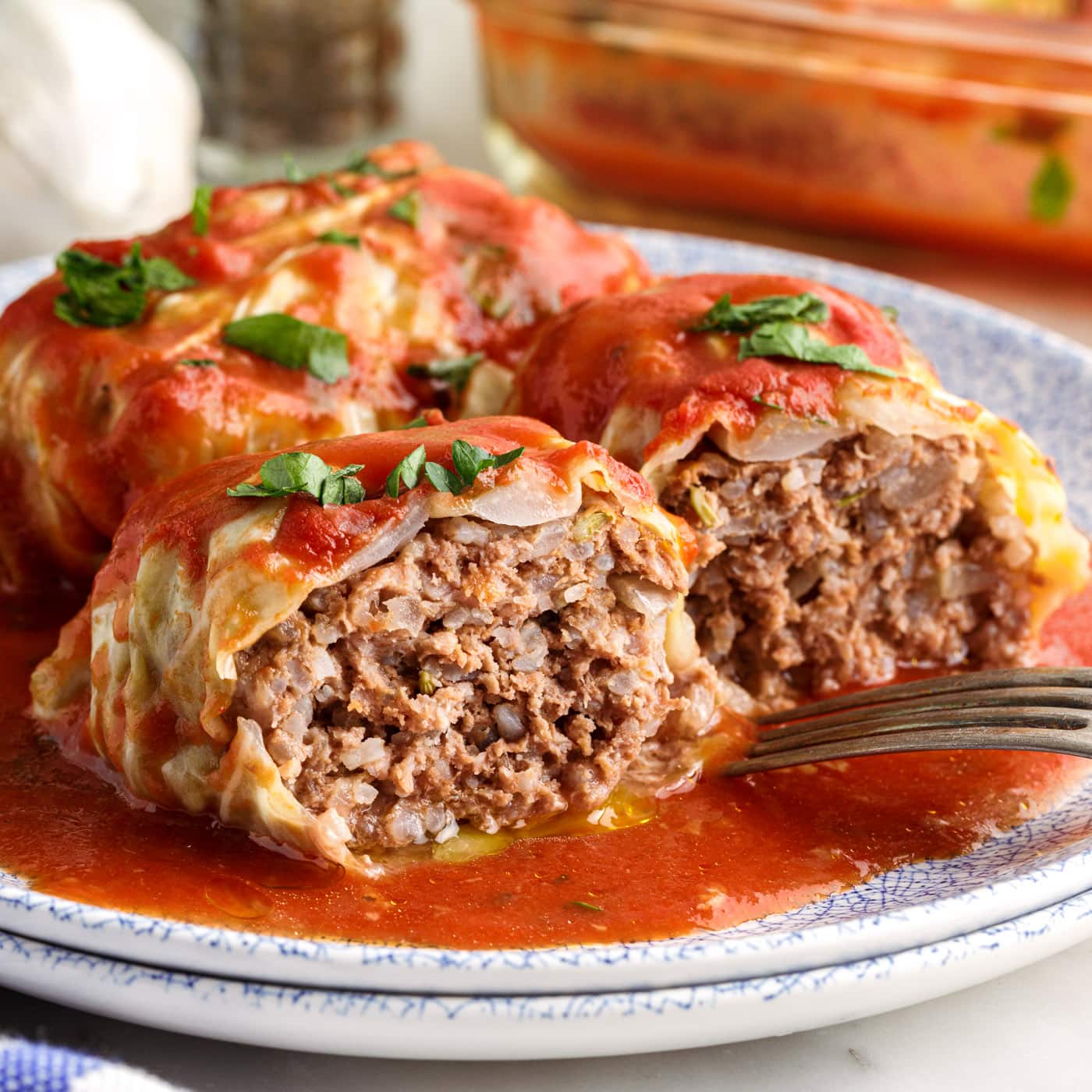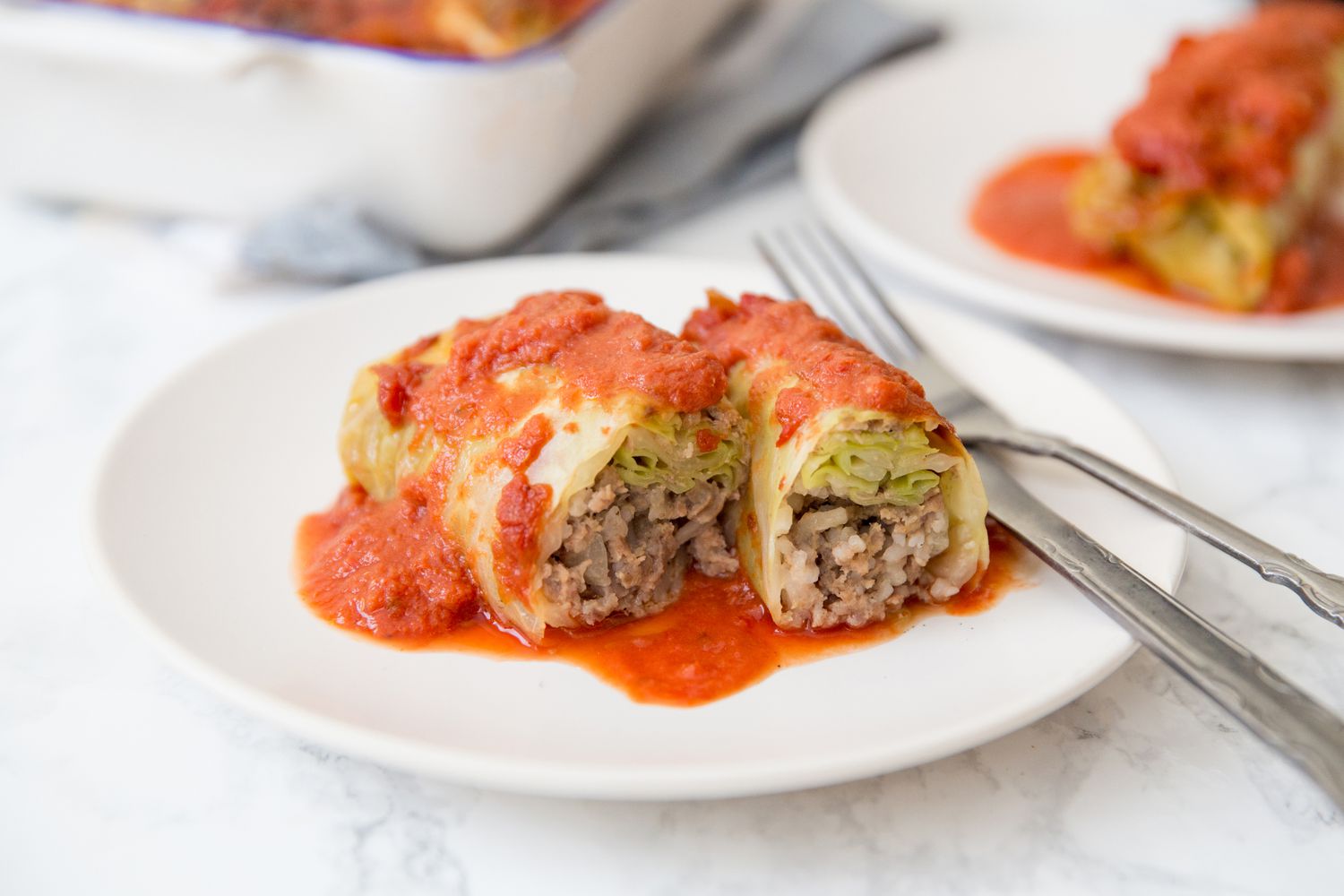Homemade Stuffed Cabbage Rolls with Meat: A Complete Guide
Stuffed cabbage rolls with meat, a beloved dish across many cultures, offer a delightful combination of flavors and textures. These hearty rolls, consisting of tender cabbage leaves enveloping a savory meat filling, hold significance in diverse cuisines worldwide. Whether it’s the Polish golabki, the Middle Eastern malfouf, or the Ukrainian holubtsi, stuffed cabbage rolls hold a cherished place on dinner tables around the globe. In this guide, we will explore the process of crafting these delectable stuffed cabbage rolls, from selecting the freshest ingredients to mastering the art of rolling and cooking them to perfection. Join us on this culinary journey as we unravel the secrets behind making delicious stuffed cabbage rolls with meat.
I. Ingredients
A. List of Ingredients
1. Cabbage leaves: Provide the outer wrapping and a tender texture.
2. Ground meat (beef, pork, or a combination): Forms the hearty filling.
3. Rice: Adds bulk to the filling and contributes to the texture.
4. Onion: Enhances flavor and adds aroma to the filling.
5. Garlic: Provides a savory depth of flavor to the filling.
6. Tomato sauce or crushed tomatoes: Forms the base of the sauce, adding acidity and sweetness.
7. Broth (vegetable or chicken): Adds moisture and flavor to the dish.
8. Herbs (such as parsley, dill, or thyme): Infuse the filling with aromatic notes.
9. Salt and pepper: Seasoning agents that enhance the overall taste.
10. Olive oil or butter: Used for sautéing and adding richness to the filling.
B. Explanation of Ingredients’ Roles

– Cabbage leaves: Serve as the outer casing and provide a nutritious base.
– Ground meat: Forms the protein-rich core of the filling, offering a hearty and satisfying texture.
– Rice: Acts as a filler, absorbing flavors and adding substance to the filling.
– Onion and garlic: Contribute aromatic depth and savory flavor to the filling.
– Tomato sauce or crushed tomatoes: Create a flavorful and slightly tangy sauce that complements the stuffed cabbage rolls.
– Broth: Adds moisture to prevent dryness and infuses the dish with additional flavor.
– Herbs: Provide freshness and aroma, enhancing the overall taste profile of the dish.
– Salt and pepper: Season the filling and sauce, balancing flavors and enhancing taste.
– Olive oil or butter: Used for sautéing ingredients, adding richness, and preventing sticking.
C. Possible Substitutions
– Cabbage leaves: Swiss chard or grape leaves can be used as alternatives for wrapping.
– Ground meat: Ground turkey or chicken can be substituted for beef or pork for a leaner option.
– Rice: Quinoa or bulgur can replace rice for a different texture and nutritional profile.
– Tomato sauce: Crushed tomatoes or marinara sauce can be used as substitutes, adjusting seasoning as needed.
– Broth: Water can be used instead of broth, though it may result in a slightly less flavorful dish.
– Herbs: Dried herbs can be used instead of fresh, though fresh herbs typically provide more flavor.
– Olive oil or butter: Vegetable oil or margarine can be substituted for olive oil or butter for a different flavor profile.
II. Preparation
A. Preparing the Cabbage Leaves
Selecting the Right Cabbage
- Choose a firm, medium-sized cabbage head with tightly packed leaves.
- Avoid cabbages with wilted or discolored outer leaves.
Boiling or Steaming the Cabbage to Soften Leaves
- Remove any damaged outer leaves from the cabbage head.
- Bring a large pot of salted water to a boil.
- Carefully place the whole cabbage head into the boiling water.
- Allow the cabbage to boil for a few minutes until the outer leaves become tender and pliable.
- Remove the cabbage from the pot and carefully separate the softened leaves.
B. Preparing the Filling:
Choosing the Meat and Seasoning It

- Select high-quality ground meat such as beef, pork, or a combination thereof.
- Season the meat generously with salt, pepper, and any desired spices or herbs for added flavor.
Mixing Meat with Other Ingredients for the Filling
- In a mixing bowl, combine the seasoned ground meat with cooked rice, finely chopped onions, minced garlic, and chopped herbs.
- Mix the ingredients thoroughly until well combined, ensuring an even distribution of flavors.
C. Preparing the Sauce
Selecting and Mixing Ingredients for the Sauce
- In a separate bowl, combine tomato sauce or crushed tomatoes with broth (vegetable or chicken) to create the base of the sauce.
- Season the sauce with additional herbs, spices, salt, and pepper to taste.
- Stir well to ensure all ingredients are fully incorporated.
Adjusting the Sauce According to Taste Preferences
- Taste the sauce and adjust the seasoning as needed, adding more salt, pepper, or herbs to achieve the desired flavor profile.
- For a sweeter sauce, add a pinch of sugar or a splash of balsamic vinegar.
- For a spicier sauce, incorporate crushed red pepper flakes or hot sauce according to personal preference.
III. Assembly
A. Rolling the stuffed cabbage rolls
Placing Filling on Cabbage Leaves
- Take a softened cabbage leaf and place it flat on a clean work surface.
- Spoon a portion of the prepared filling onto the center of the cabbage leaf.
- Spread the filling evenly, leaving some space around the edges to facilitate rolling.
Rolling Technique to Ensure Compactness
- Fold the bottom edge of the cabbage leaf over the filling.
- Fold in the sides of the leaf toward the center.
- Roll the cabbage leaf tightly over the filling, continuing until the entire leaf is wrapped around the filling, forming a compact roll.
B. Arranging the stuffed cabbage rolls in a Cooking Vessel
Choosing an Appropriate Cooking Dish

- Select a large, oven-safe dish or pot that can accommodate all the stuffed cabbage rolls in a single layer.
- Ensure the dish has high sides to hold the sauce and prevent overflow during cooking.
Arranging the Rolls Snugly to Prevent Unraveling
- Place each rolled cabbage roll seam-side down in the cooking vessel.
- Arrange the stuffed cabbage rolls snugly against each other to prevent them from unraveling during cooking.
- Pack the stuffed cabbage rolls tightly, but leave a little space between them to allow for even cooking and sauce distribution.
IV. Cooking
A. Cooking Methods
Baking
- Preheat the oven to the specified temperature.
- Place the arranged stuffed cabbage rolls in a baking dish.
- Cover the rolls with the prepared sauce.
- Bake in the preheated oven until the stuffed cabbage rolls are cooked through and the sauce is bubbly and caramelized.
Stovetop Cooking
- Place the arranged stuffed cabbage rolls in a large pot or Dutch oven.
- Pour the prepared sauce over the rolls.
- Cover the pot and cook over medium heat until the stuffed cabbage rolls are tender and the sauce has thickened.
B. Cooking Time and Temperature Considerations
- For baking: Typically, stuffed cabbage rolls are baked at around 350°F to 375°F (175°C to 190°C) for 45 minutes to 1 hour, or until the cabbage is tender and the filling is cooked through.
- For stovetop cooking: Simmer the stuffed cabbage rolls over low to medium heat for approximately 45 minutes to 1 hour, ensuring that the cabbage is cooked through and the filling is heated to a safe temperature.
C. Testing for Doneness
- Insert a fork or knife into the center of a cabbage roll to check if the filling is fully cooked and the cabbage is tender.
- The internal temperature of the filling should reach at least 160°F (71°C) to ensure it is safe to eat.
D. Serving Suggestions and Garnishes
- Serve the stuffed cabbage rolls hot, straight from the oven or stovetop.
- Garnish with chopped fresh herbs such as parsley or dill for a burst of freshness.
- Accompany the stuffed cabbage rolls with a dollop of sour cream or yogurt for a creamy contrast.
- Serve over a bed of cooked grains such as rice or quinoa for a complete meal.
- Pair with crusty bread and a side salad for a satisfying and well-rounded dining experience.
Making stuffed cabbage rolls with meat is a rewarding culinary experience that offers a harmonious blend of flavors and textures. Throughout this guide, we’ve outlined the step-by-step process of preparing this classic dish, from selecting the finest ingredients to cooking it to perfection. By carefully choosing the right cabbage, preparing a flavorful filling, and cooking with attention to detail, you can create stuffed cabbage rolls that are both hearty and delicious.
| Steps | Description |
|---|---|
| 1. Prep Cabbage | Select and soften cabbage leaves by boiling or steaming. |
| 2. Prepare Filling | Season ground meat and mix with rice, onions, garlic, and herbs. |
| 3. Make Sauce | Combine tomato sauce with broth and seasonings for the sauce. |
| 4. Roll Cabbage | Fill cabbage leaves with meat mixture, roll tightly. |
| 5. Arrange Rolls | Place rolls in a dish, seam-side down, snugly to prevent unravelling. |
| 6. Cook | Bake or simmer rolls in sauce until tender and cooked through. |
| 7. Serve | Garnish with herbs and serve hot with preferred accompaniments. |
The appeal of stuffed cabbage rolls lies not only in their comforting taste but also in their versatility. Whether you prefer them baked in a savory tomato sauce or simmered on the stovetop, stuffed cabbage rolls can be adapted to suit your taste preferences and dietary needs. Their ability to incorporate a variety of ingredients and flavors makes them a beloved dish in cuisines around the world.
As you embark on your cabbage roll-making journey, I encourage you to experiment with different fillings, sauces, and cooking methods to tailor the dish to your liking. Add your own personal touches, such as incorporating unique herbs or spices, to create a signature cabbage roll recipe that reflects your culinary creativity.
With a little patience and a lot of love, you’ll soon be enjoying homemade stuffed cabbage rolls that are sure to delight your taste buds and impress your family and friends. So roll up your sleeves, gather your ingredients, and let the culinary adventure begin!
